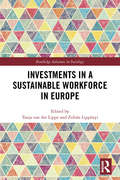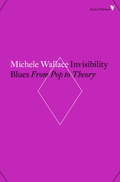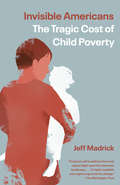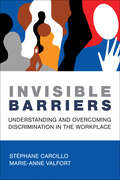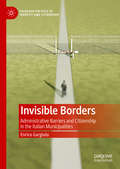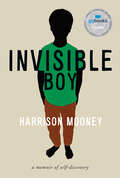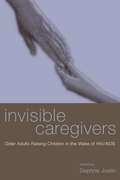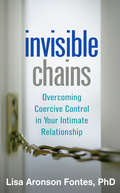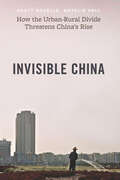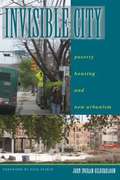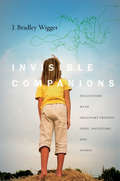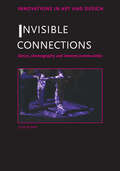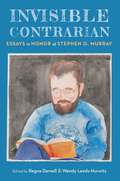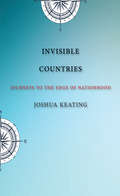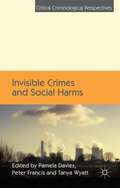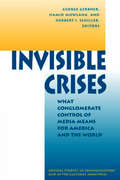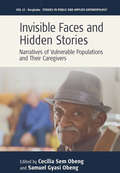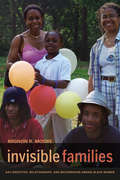- Table View
- List View
Investments in a Sustainable Workforce in Europe (Routledge Advances in Sociology)
by Tanja van der Lippe Zoltán LippényiA sustainable European workforce has become increasingly relevant in our present day and age. Flexibility and job insecurity are omnipresent; organizational workforces are displaying growing diversity with respect to age, gender, ethnicity and family status; and Europe’s welfare states are delegating more and more responsibility for the well-being of workers to employers. Now more so than ever, organizations need to consider investing in workers to improve their performance and level of satisfaction. These investments can take many forms, including flexible work arrangements, training plans, child-related policies and health programs. The crucial question is how to make this happen. Why do some organizations invest more and others less in their employees? Why do some employees make use of these investments and while others do not? Why do such investments sometimes improve employee performance and satisfaction and sometimes not? This book addresses precisely these questions. The book contributes a new, large-scale survey of 259 organizations, 869 work units, and 11,011 employees in six diverse economic sectors in the Bulgaria, Finland, Germany, Hungary, the Netherlands, Portugal, Spain, Sweden and UK to study the causes and consequences of organizational investments. This book appeals to undergraduate and postgraduate students, researchers and lecturers in the fields of Sociology, Business and Management, and Organizational Studies. It will also be useful for practitioners of Human Resource Management and others interested in workforce sustainability.
Invisibility Blues: From Pop to Theory
by Michele WallaceClassic work of black feminism First published in 1990, Michele Wallace's Invisibility Blues is widely regarded as a landmark in the history of black feminism. Wallace's considerations of the black experience in America include recollections of her early life in Harlem; a look at the continued underrepresentation of black voices in politics, media, and culture; and the legacy of such figures as Zora Neale Hurston, Toni Cade Bambara, Toni Morrison,and Alice Walker. Wallace addresses the tensions between race, gender, and society, bringing them into the open with a singular mix of literary virtuosity and scholarly rigor. Invisibility Blues challenges and informs with the plain-spoken truth that has made it an acknowledged classic.From the Trade Paperback edition.
Invisibility by Design: Women and Labor in Japan's Digital Economy
by Gabriella LukácsIn the wake of labor market deregulation during the 2000s, online content sharing and social networking platforms were promoted in Japan as new sites of work that were accessible to anyone. Enticed by the chance to build personally fulfilling careers, many young women entered Japan's digital economy by performing unpaid labor as photographers, net idols, bloggers, online traders, and cell phone novelists. While some women leveraged digital technology to create successful careers, most did not. In Invisibility by Design Gabriella Lukács traces how these women's unpaid labor became the engine of Japan's digital economy. Drawing on interviews with young women who strove to sculpt careers in the digital economy, Lukács shows how platform owners tapped unpaid labor to create innovative profit-generating practices without employing workers, thereby rendering women's labor invisible. By drawing out the ways in which labor precarity generates a demand for feminized affective labor, Lukács underscores the fallacy of the digital economy as a more democratic, egalitarian, and inclusive mode of production.
Invisible Americans: The Tragic Cost of Child Poverty
by Jeff MadrickAn essential, and impossible-to-ignore, examination of one of the most pressing, harmful, and heartbreaking problems facing our country: the widespread poverty among American children.By official count, more than one out of every six American children live beneath the poverty line. But statistics alone tell little of the story. In Invisible Americans, Jeff Madrick brings to light the often invisible reality and irreparable damage of child poverty in America. Keeping his focus on the children, he examines the roots of the problem, including the toothless remnants of our social welfare system, entrenched racism, and a government unmotivated to help the most voiceless citizens. Backed by new and unambiguous research, he makes clear the devastating consequences of growing up poor: living in poverty, even temporarily, is detrimental to cognitive abilities, emotional control, and the overall health of children. The cost to society is incalculable. The inaction of politicians is unacceptable. Still, Madrick argues, there may be more reason to hope now than ever before. Rather than attempting to treat the symptoms of poverty, we might be able to ameliorate its worst effects through a single, simple, and politically feasible policy that he lays out in this impassioned and urgent call to arms.
Invisible Ball of Dreams: Literary Representations of Baseball behind the Color Line
by Emily Ruth RutterWinner of the 2018 John Coates Next Generation Award from the Negro Leagues Research Committee of the Society for American Baseball Research Although many Americans think of Jackie Robinson when considering the story of segregation in baseball, a long history of tragedies and triumphs precede Robinson’s momentous debut with the Brooklyn Dodgers. From the pioneering Cuban Giants (1885-1915) to the Negro Leagues (1920-1960), Black baseball was a long-standing staple of African American communities. While many of its artifacts and statistics are lost, Black baseball figured vibrantly in films, novels, plays, and poems. In Invisible Ball of Dreams: Literary Representations of Baseball behind the Color Line, author Emily Ruth Rutter examines wide-ranging representations of this history by William Brashler, Jerome Charyn, August Wilson, Gloria Naylor, Harmony Holiday, Kevin King, Kadir Nelson, and Denzel Washington, among others. Reading representations across the literary color line, Rutter opens a propitious space for exploring Black cultural pride and residual frustrations with racial hypocrisies on the one hand and the benefits and limitations of white empathy on the other. Exploring these topics is necessary to the project of enriching the archives of segregated baseball in particular and African American cultural history more generally.
Invisible Barriers: Understanding and Overcoming Discrimination in the Workplace
by Stephane Carcillo Marie-Anne ValfortAn essential resource for anyone committed to fostering equality and fairness in employment—with actionable proposals for public policy that can address these inequities.In a world where discrimination against minorities remains a pressing issue even in economically and socially advanced countries, Invisible Barriers delves into the multifaceted nature of this pervasive problem. Drawing on extensive research from economics, management, psychology, and sociology, Stéphane Carcillo and Marie-Anne Valfort present a comprehensive examination of discriminatory practices in employment and their profound social and economic impacts.The first part of the book methodically explores the forms, sources, and consequences of discrimination in the labor market, offering readers a solid understanding of the approaches used to measure and identify discriminatory practices. In the second part, the book details research findings on specific groups, illustrating how discrimination manifests uniquely across different demographics: women, ethnic minorities, older workers, LGBTIQ+, and more. From recruitment biases to career advancement hurdles, the book sheds light on the varied and often hidden ways that discrimination operates. Finally, the authors discuss public policies aimed at mitigating discrimination, advocating for a multifaceted approach that combines punitive measures with incentives, educational programs, and communication campaigns to effectively combat biases, prejudices, and stereotypes.
Invisible Borders: Administrative Barriers and Citizenship in the Italian Municipalities (Palgrave Politics of Identity and Citizenship Series)
by Enrico GargiuloThis book analyses residency, a form of municipal membership that plays a strategic role in administrative processes in Italy. Residency is a two-faced juridical status: a means for exercising rights and moving freely within a state territory and, at the same time, a tool of control that operates through identification and registration. Gargiulo investigates residency both historically and theoretically, showing that the status of resident is a special kind of border, namely, a status border, which draws the lines of local citizenship. By explaining that the mechanisms of exclusion from residency work as administrative barriers, and showing their aims and effects in terms of civic stratification and differential inclusion, this book contributes to the debates on local citizenship, borders, and discretionary power.‘’While the legal concepts of (un)authorized presence and citizenship in bounded territorial states govern how we envision “immigrants” and debate their treatment, this perceptive book raises novel issues. Local residency registration, studied with rich material from Italy, regulates access to socially distributed resources, and shapes stratification of labor. The case made in this book is original, penetrating, and theoretically insightful. Scholars of migration will want to read this exceptional work.’’ — Josiah Heyman, University of Texas at El Paso, USA‘’Enrico Gargiulo has made an important addition to our sociological understanding of the ways in which states and individuals relate to one another. The humble, often taken-for-granted status of "resident" turns out to be a major pathway to rights and privileges for individuals who have it; those without it may be legal non-persons who barely exist in the eyes of the state. This book is a major contribution to our expanding appreciation of the many kinds of borders, both physical and conceptual, that shape our relationships with the social and political world.’’ — John Torpey, Presidential Professor of Sociology and History, Director, Ralph Bunche, Institute for International Studies, CUNY Graduate Center, USA
Invisible Boy: A Memoir of Self-Discovery (Truth To Power Ser.)
by Harrison MooneyA narrative that amplifies a voice rarely heard—that of the child at the centre of a transracial adoption—and a searing account of being raised by religious fundamentalistsHarrison Mooney was born to a West African mother and adopted as an infant by a white evangelical family. Growing up as a Black child, Harry’s racial identity is mocked and derided, while at the same time he is made to participate in the fervour of his family’s revivalist church. Confused and crushed by fundamentalist dogma and consistently abused for his colour, Harry must transition from child to young adult while navigating and surviving zealotry, paranoia and prejudice.After years of internalized anti-Blackness, Harry begins to redefine his terms and reconsider his history. His journey from white cult to Black consciousness culminates in a moving reunion with his biological mother, who waited twenty-five years for the chance to tell her son the truth: she wanted to keep him.This powerful memoir considers the controversial practice of transracial adoption from the perspective of families that are torn apart and children who are stripped of their culture, all in order to fill evangelical communities’ demand for babies. Throughout this most timely tale of race, religion and displacement, Harrison Mooney’s wry, evocative prose renders his deeply personal tale of identity accessible and light, giving us a Black coming-of-age narrative set in a world with little love for Black children.
Invisible Caregivers: Older Adults Raising Children in the Wake of HIV/AIDS
by Daphne JoslinAn understudied aspect of the HIV/AIDS epidemic is the creation of hundreds of thousands of grandparent-headed households that have become home to children bereft of one or both of their parents. Such "skip-generation parenting" presents a host of challenges to the families involved and the social programs designed to assist them. Despite this unprecedented caregiving responsibility, older surrogate parents remain relatively invisible, hidden in the shadows of HIV care and the demands of raising a child. The primary goal of Invisible Caregivers is to generate, support, and guide program and policy initiatives designed to meet the needs of elder surrogates and their families.Most social service programs are not able to identify the needs of older surrogates, often because these surrogate parents in HIV-infected families are reluctant to make their needs known for fear of social stigma or possible reductions of benefits. Multiple systemic barriers to case management and other services also frustrate attempts to bring available resources to elder caregivers. These barriers include professional ignorance or denial that HIV affects surrogates, eligibility restrictions through CARE, limited funding and age restriction on OAA, and a fragmented health and human service system. Because the issues facing elder caregivers are many and varied, this collection covers a host of issues: community health, aging, HIV services, child welfare, education, public policy, and mental health.
Invisible Chains: Overcoming Coercive Control in Your Intimate Relationship
by Lisa Aronson FontesWhen a man showers all of his attention on a woman, it can feel incredibly romantic, and can blind her to hints of problems ahead. But what happens when that attentiveness becomes domination? In some relationships, the desire to control leads to jealousy, threats, micromanaging--even physical violence. If you or someone you care about are trapped in a web of coercive control, this book provides answers, hope, and a way out. Lisa Aronson Fontes draws on both professional expertise and personal experience to help you:*Recognize controlling behaviors of all kinds.*Understand why this destructive pattern occurs.*Determine whether you are in danger and if your partner can change.*Protect yourself and your kids.*Find the support and resources you need.*Take action to improve or end your relationship.*Regain your freedom and independence.
Invisible Child: Poverty, Survival and Hope in an American City
by Andrea ElliottInvisible Child follows eight dramatic years in the life of a girl whose imagination is as soaring as the skyscrapers near her Brooklyn shelter. Dasani was named after the bottled water that signaled Brooklyn’s gentrification and the shared aspirations of a divided city. <p><p>In this sweeping narrative, Elliott weaves the story of Dasani’s childhood with the history of her family, tracing the passage of their ancestors from slavery to the Great Migration north. As Dasani comes of age, the homeless crisis in New York City has exploded amid the deepening chasm between rich and poor. <p><p>Dasani must guide her siblings through a city riddled by hunger, violence, drug addiction, homelessness, and the monitoring of child protection services. Out on the street, Dasani becomes a fierce fighter to protect the ones she loves. When she finally escapes city life to enroll in a boarding school, she faces an impossible question: What if leaving poverty means abandoning your family, and yourself? <p><p>By turns heartbreaking and inspiring, Invisible Child tells an astonishing story about the power of resilience, the importance of family, and the cost of inequality. Based on nearly a decade of reporting, Invisible Child illuminates some of the most critical issues in contemporary America through the life of one remarkable girl.
Invisible China: How the Urban-Rural Divide Threatens China’s Rise
by Scott Rozelle Natalie HellAs the glittering skyline in Shanghai seemingly attests, China has quickly transformed itself from a place of stark poverty into a modern, urban, technologically savvy economic powerhouse. But as Scott Rozelle and Natalie Hell show in Invisible China, the truth is much more complicated and might be a serious cause for concern. China’s growth has relied heavily on unskilled labor. Most of the workers who have fueled the country’s rise come from rural villages and have never been to high school. While this national growth strategy has been effective for three decades, the unskilled wage rate is finally rising, inducing companies inside China to automate at an unprecedented rate and triggering an exodus of companies seeking cheaper labor in other countries. Ten years ago, almost every product for sale in an American Walmart was made in China. Today, that is no longer the case. With the changing demand for labor, China seems to have no good back-up plan. For all of its investment in physical infrastructure, for decades China failed to invest enough in its people. Recent progress may come too late. Drawing on extensive surveys on the ground in China, Rozelle and Hell reveal that while China may be the second-largest economy in the world, its labor force has one of the lowest levels of education of any comparable country. Over half of China’s population—as well as a vast majority of its children—are from rural areas. Their low levels of basic education may leave many unable to find work in the formal workplace as China’s economy changes and manufacturing jobs move elsewhere. In Invisible China, Rozelle and Hell speak not only to an urgent humanitarian concern but also a potential economic crisis that could upend economies and foreign relations around the globe. If too many are left structurally unemployable, the implications both inside and outside of China could be serious. Understanding the situation in China today is essential if we are to avoid a potential crisis of international proportions. This book is an urgent and timely call to action that should be read by economists, policymakers, the business community, and general readers alike.
Invisible City
by John Ingram GilderbloomA legendary figure in the realms of public policy and academia, John Gilderbloom is one of the foremost urban-planning researchers of our time, producing groundbreaking studies on housing markets, design, location, regulation, financing, and community building. Now, in Invisible City, he turns his eye to fundamental questions regarding housing for the elderly, the disabled, and the poor. Why is it that some locales can offer affordable, accessible, and attractive housing, while the large majority of cities fail to do so? Invisible City calls for a brave new housing paradigm that makes the needs of marginalized populations visible to policy makers. Drawing on fascinating case studies in Houston, Louisville, and New Orleans, and analyzing census information as well as policy reports, Gilderbloom offers a comprehensive, engaging, and optimistic theory of how housing can be remade with a progressive vision. While many contemporary urban scholars have failed to capture the dynamics of what is happening in our cities, Gilderbloom presents a new vision of shelter as a force that shapes all residents.
Invisible Companions: Encounters with Imaginary Friends, Gods, Ancestors, and Angels (Spiritual Phenomena)
by J. Bradley WiggerFrom the US to Nepal, author J. Bradley Wigger travels five countries on three continents to hear children describe their invisible friends—one-hundred-year-old robins and blue dogs, dinosaurs and teapots, pretend families and shape-shifting aliens—companions springing from the deep well of childhood imagination. Drawing on these interviews, as well as a new wave of developmental research, he finds a fluid and flexible quality to the imaginative mind that is central to learning, co-operation, and paradoxically, to real-world rationality. Yet Wigger steps beyond psychological territory to explore the religious significance of the kind of mind that develops relationships with invisible beings. Alongside Cinderella the blue dog, Quack-Quack the duck, and Dino the dinosaur are angels, ancestors, spirits, and gods. What he uncovers is a profound capacity in the religious imagination to see through the surface of reality to more than meets the eye. Punctuated throughout by children's colorful drawings of their see-through interlocutors, the book is highly engaging and alternately endearing, moving, and humorous. Not just for parents or for those who work with children, Invisible Companions will appeal to anyone interested in our mind's creative and spiritual possibilities.
Invisible Connections: Dance, Choreography and Internet Communities (Innovations In Art And Design Ser.)
by Sita PopatThe first and only book to focus on dance on the Internet, Sita Popat‘s fascinating Invisible Connections examines how Internet and communication technologies offer dance and theatre new platforms for creating and performing work, and how opportunities for remote interaction and collaboration are available on a scale never before imaginable.Drawing
Invisible Contrarian: Essays in Honor of Stephen O. Murray (Critical Studies in the History of Anthropology)
by Regna Darnell Wendy Leeds-HurwitzIn Invisible Contrarian Regna Darnell and Wendy Leeds-Hurwitz have assembled scholars to memorialize and celebrate the prescient vision and interdisciplinary contributions of the late Stephen O. Murray (1950–2019), who did pioneering research in ethnolinguistics and anthropology of gender and homosexuality. His socially relevant work continues to provide a cogent example of an emergent, forward-looking anthropology for the twenty-first century. Murray&’s wide-ranging work included linguistics, regional ethnography in Latin America and Asia, activism, history of anthropology in relation to social sciences, and migration studies. Along with a complete list of his publications, Invisible Contrarian highlights Murray&’s methodological innovations and includes key writings that remain little known, since he never pursued a tenured research position. Murray&’s significant, prolific contributions deserve not only to be reexamined but to be shared with contemporary and future audiences. Ideal both as a primer for those who have not yet read Murray&’s work and as an in-depth resource for those already familiar with him, this volume demonstrates the wide-ranging accomplishments of a man who modeled how to be an independent scholar outside an academic position.
Invisible Countries: Journeys to the Edge of Nationhood
by Joshua KeatingA journalist explores how our world&’s borders came to be and how self-proclaimed countries across the globe could change the map. What is a country? While certain basic criteria—borders, a government, and recognition from other countries—seem obvious, journalist Joshua Keating investigates what happens in areas of the world that exist as exceptions to these rules. Invisible Countries looks at semiautonomous countries such as Abkhazia, Kurdistan, and Somaliland, as well as a Mohawk reservation straddling the U.S.-Canada border, and an island nation whose very existence is threatened by climate change. Through stories about these would-be countries&’ efforts at self-determination, Keating shows that there is no universal legal authority determining what a country is. He also argues that economic, cultural, and environmental forces could soon bring an end to our long period of cartographical stasis. Keating combines history with incisive observations drawn from his travels and interviews with residents, political leaders, and scholars in each of these &“invisible countries.&”
Invisible Crimes and Social Harms
by Pamela Davies Peter Francis Tanya WyattThis unique collection explores the continuing invisibility of much crime and victimization, and the lack of adequate responses to them. Shaping the lens through which criminology and victimology is approached in the twenty-first century, the volume examines major issues including (in)justice, risks, rights, regulation and enforcement.
Invisible Crises: What Conglomerate Control of Media Means for America and the World (Critical Studies in Communication and in the Cultural Industries)
by George GerbnerHidden from public sight and mind today are invisible crises that threaten our democracy and existence more than the crises we know about—or think we know about. These invisible crises include the promotion of practices that drug, hurt, poison, and kill thousands every day; cults of violence that desensitize, terrorize, and brutalize; the growing siege mentality of our cities; widening resource gaps and the most glaring inequalities in the industrial world; the costly neglect of vital institutions such as public education and the arts; and media-assisted make-believe image politics corrupting the electoral process.Deprived of sustained attention but bombarded by eruptions of surface consequences (often presented as unique events stripped of historical context), people ar bewildered, fearful, angry, and cynical.The contributors to this volume—exploring such unattended crises, analyzing why they are hidden, and focusing on the increasing concentration of culture-power that keeps them from view—maintain that a profound general crisis of social vision, public communication, and representative government underlies all of the invisible crises.
Invisible Doctrine: The Secret History of Neoliberalism
by George Monbiot Peter HutchisonWe live under an ideology that preys on every aspect of our lives: our education and our jobs; our healthcare and our leisure; our relationships and our mental well-being; the planet we inhabit—the very air we breathe. It is everywhere. Yet for most people, it has no name. It seems inescapable, like a natural law.But trace it back to its roots, and you see that this ideology is neither inevitable nor immutable. It was conceived and propagated—and then concealed—by the powerful few. Our task is to bring it into the light—and to build a new system that is worth fighting for. Neoliberalism.Do you know what it is?
Invisible Doctrine: The Secret History of Neoliberalism
by George Monbiot Peter Hutchison#1 SUNDAY TIMES BESTSELLER • A &“fantastic&” (Mark Ruffalo), fiercely argued takedown of neoliberalism that not only defines this slippery concept but connects it to the climate crisis, poverty, and fascism—and shows us how to fight back.&“Incisive, illuminating, eye-opening—an unsparing anatomy of the great ideological beast stalking our times, often whispered about and yet never so clearly in view.&”—David Wallace-Wells, author of The Uninhabitable EarthNeoliberalism is the dominant ideology of our time. It shapes us in countless ways, yet most of us struggle to articulate what it is. Worse, we have been persuaded to accept this extreme creed as a kind of natural law. In Invisible Doctrine, journalist George Monbiot and filmmaker Peter Hutchison shatter this myth. They show how a fringe philosophy in the 1930s—championing competition as the defining feature of humankind—was systematically hijacked by a group of wealthy elites, determined to guard their fortunes and power. Think tanks, corporations, the media, university departments and politicians were all deployed to promote the idea that people are consumers, rather than citizens.One of the most pernicious effects has been to make our various crises—from climate disasters to economic crashes, from the degradation of public services to rampant child poverty—seem unrelated. In fact, they have all been exacerbated by the &“invisible doctrine,&” which subordinates democracy to the power of money. Monbiot and Hutchison connect the dots—and trace a direct line from neoliberalism to fascism, which preys on people&’s hopelessness and desperation.Speaking out against the fairy tale of capitalism and populist conspiracy theories, Monbiot and Hutchison lay the groundwork for a new politics, one based on truly participatory democracy and &“private sufficiency, public luxury&”: an inspiring vision that could help bring the neoliberal era to an end.
Invisible Education: Posthuman Explorations of Everyday Learning (Postqualitative, New Materialist and Critical Posthumanist Research)
by Jocey QuinnThis original and challenging book introduces the ground-breaking concept of ‘invisible education’, theorising it with critical posthuman concepts and demonstrating it through a wide range of empirical research. Invisible education is the learning that happens in everyday life: it is invisible because it is purposively ignored and devalued, and it is education because it is powerful and formative. Far from being marginal, this is where the future is being formed. The book challenges the feel-good fiction of social mobility through formal education, replacing it with the new concept of future mutabilities, shaped through invisible education. The book is the first to bring together lifelong learning and critical posthumanism and does so in ways that are mutually illuminating. The book draws on a wide range of funded empirical research on invisible education: exploring landscapes, animals and things (material, immaterial and uncanny), activism, volunteering and work, home lives and care, and global contexts of conflict. It charts how invisible education plays a crucial role in the lives of marginalised people, including young people, activists, postverbal people, carers, women escaping domestic abuse and many others. Combining posthuman ideas with memoir, poetry, art and fiction, it is creative, intellectually stimulating and readable.
Invisible Faces and Hidden Stories: Narratives of Vulnerable Populations and Their Caregivers (Studies in Public and Applied Anthropology #12)
by Cecilia Sem Obeng Samuel Gyasi ObengDealing with narratives of vulnerable populations, this book looks at how they deal with dimensions of their social life, especially in regards to health. It reflects the socio-political ecologies like public hostility and stereotyping, neglect of their unique health needs, their courage to overcome adversity, and the love of family and healthcare providers in mitigating their problems. American society likes to give the impression that it is listening to the plight of vulnerable populations, but the stories in this volume prove otherwise.
Invisible Faces and Hidden Stories: Narratives of Vulnerable Populations and Their Caregivers (Studies in Public and Applied Anthropology #12)
by Cecilia Sem Obeng and Samuel Gyasi ObengDealing with narratives of vulnerable populations, this book looks at how they deal with dimensions of their social life, especially in regard to health. It reflects the socio-political ecologies like public hostility and stereotyping, neglect of their unique health needs, their courage to overcome adversity, and the love of family and healthcare providers in mitigating their problems. The narratives inform us about the dissimilarity between the way we speak, what we hear and how we act. American society likes to give the impression that it is listening to the plight of vulnerable populations, but the stories in this volume prove otherwise.
Invisible Families: Gay Identities, Relationships, and Motherhood Among Black Women
by Mignon MooreMignon R. Moore brings to light the family life of a group that has been largely invisible--gay women of color--in a book that challenges long-standing ideas about racial identity, family formation, and motherhood. Drawing from interviews and surveys of one hundred black gay women in New York City, Invisible Families explores the ways that race and class have influenced how these women understand their sexual orientation, find partners, and form families. In particular, the study looks at the ways in which the past experiences of women who came of age in the 1960s and 1970s shape their thinking, and have structured their lives in communities that are not always accepting of their openly gay status. Overturning generalizations about lesbian families derived largely from research focused on white, middle-class feminists, Invisible Families reveals experiences within black American and Caribbean communities as it asks how people with multiple stigmatized identities imagine and construct an individual and collective sense of self.
